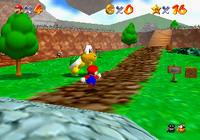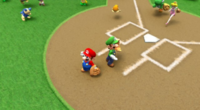Genre
This article is under construction. Therefore, please excuse its informal appearance while it is being worked on. We hope to have it completed as soon as possible.
Genres are different types of video games classified by gameplay. With over 200 entries, the Mario series has included a variety of different genres. Some games such as Super Paper Mario and Mario Super Sluggers belong to multiple genres. The oldest Mario games started out as platformers, but with the introduction of the Super Nintendo and Nintendo 64, many new genres of Mario games were created.
Types of Genres
Platform

Platform games consist of going through levels to reach a goal. The majority of Mario games fit under this category. This genre can be divided into two sub-genres; Sidescrollers and three-dimensional platformers. Sidescrollers are the most common type of platform game and usually allow travel in only one or two directions. Three-dimensional platformers allow travel in any direction and usually consist of the newer Mario platform games. A sidescroller may have three-dimensional graphics, like New Super Mario Bros. Wii but it is still classified as a sidescroller.
Role Playing
Role playing games (often abbreviated as RPGs) place Mario in a major role. Common gameplay features in RPGs include detailed storylines, a large cast of characters, and the ability to level up. Mario first appearance in a RPG was in Super Mario RPG: Legend of the Seven Stars. Later, the Paper Mario series and Mario & Luigi series were introduced. Another common feature in RPGs is the ability to use items and equip weapons, armor, clothing, and accessories.
Party
Party games are multiplayer games usually involving short mini-games. This genre is dominated by the Mario Party series, but the WarioWare series and Itadaki Street DS are also part of it. While most party games involve multiple players, some party games are single player, like certain WarioWare games. Luck is a large factor in party games, but players must also have a certain degree of skill. Party games are rarely played competitively and are usually played casually.
Racing
Racing games are a sub-genre of sports games and involve speedy competitions with other characters. The main objective in racing games is to reach the goal before the other racers and attain first place. Nearly all Mario racing games are part of the Mario Kart series, except for Diddy Kong Racing DS. All racing games in the Mario series involve items or power-ups which can do various things like slow down the other racers or speed up the player. Racing games also build on this by providing battle modes in which items are used as weapons. Online racing was introduced with the release of Mario Kart DS and is integrated in every Mario racing game since.
Sports

Sports games, like the name implies, are games based on sports. Unlike most conventional sports games, Mario sports games feature items and obstacles. Racing and fighting games are sub-genres of sports games. The genre started with Golf for the Nintendo Entertainment System. This genre of Mario games did not become well known until the release of the Nintendo 64 with games like Mario Tennis 64 and Mario Golf 64. Currently, Mario sports games include golf, tennis, soccer, basketball, baseball, dancing, and Olympic events.
Fighting
Fighting games pit characters against each other in combat. The objective of fighting games is to knock out the other characters. Fighting games are a sub-genre of sports games. This genre has exclusively been a part of crossover games. The Super Smash Bros. series contains all Mario fighting games. Mario's first appearance in a fighting game was as a referee in Punch-Out!!. His first playable role in a fighting game was in Super Smash Bros., along wth Luigi, Yoshi, and Donkey Kong. Fighting games in the Mario series have significant differences from arcade fighting games. Instead of depleting the enemy's health, the player must knock the enemy off the screen. Items and obstacle are also available whereas most fighting games do not.
Puzzle
Puzzle games test the player's reflexes and knowledge. The objective in most Mario puzzle games is to clear the screen of various objects similar to Tetris. However, a few Mario puzzle games incorporate different types of gameplay such as picross and mahjong. Games belonging to this genre include the Dr. Mario series, Wario's Woods, and Yoshi's Cookie. Unlike most Mario games, puzzle games do not have items. However, they generally have a large cast of characters.
Edutainment
Edutainment games are meant to both educate and entertain the player. Compared to the other genres in the Mario series, the number of edutainment games is relatively small. The purpose of edutainment games is to solve mysteries or simply learn how to do something, like typing or math. Games belonging to this genre are usually developed by a third party company. Due to this, characters may have different personalities. For example, Mario has full dialogue in Mario's Time Machine, despite the fact that he rarely speaks in other games.